Ninja H2 SX test: sporty road bike, in green and against everything !
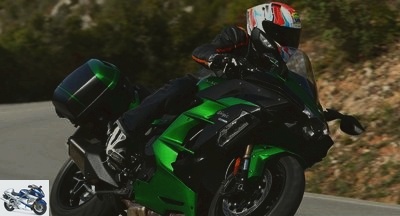
Kawasaki has no shortage of air: three years after the launch of its Ninja H2 / R, Akashi’s firm is releasing a new supercharged motorcycle! Equipped with the second generation of 1000 cc 4-cylinder compressor, the Ninja H2 SX has just been tested by Site… Test.
Ninja H2 SX test page 4 – Technical point
Engine
Externally, the engine of the Ninja H2 SX does not differ from that of the original Ninja H2 / R … And yet, according to project manager Hiroyuki Watanabe, the changes are so numerous that it would have been quicker to quote their common rooms !
"The crankcases, the valves … that’s about it", he tells us with a diagram (below) showing in green the differences between the two generations of 4-cylinders. supercharged. The first was dedicated to maximum performance … The second is refined along three axes: "consumption, docility and emissions", lists Watanabe San.
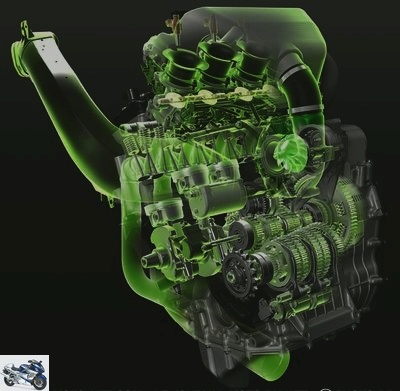
If the dimensions – therefore the displacement – are unchanged (see the technical sheet on the following page), the pistons have been redesigned. And these are not the only ones: "the end of the blades of the 69 mm diameter turbine is modified, as well as the intake system, the cylinder heads and camshafts, the cylinders and crankshaft, the exhaust and the ‘stepping of the box (primary reduction, 1st and 2nd longer, Editor’s note) ", continues our venerable host.
Mr. Watanabe, who was chief engine manufacturer on the 2003 and 2010 Z1000, the 2007 ZX-6R and the Ninja H2 / R, obviously took great pleasure in developing this – hardly – wiser version of the water-fed water mill. air: "it was a very exciting project because the progress was obvious".
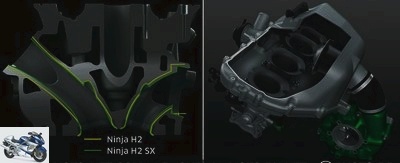
By playing with the famous turbine in particular, engineers could increase the power to 5, 10 or 15 horses while improving consumption … "But we also sometimes did the opposite!" Exclaims the Project Leader. . "Nothing to do with the development of a Supersport 600 cc" atmo "on which we track (tracked, Editor’s note!) The slightest horse …"
In the end, the engine of the Ninja H2 SX is satisfied with a maximum speed of 12,500 rpm (Vs 13,200 rpm on the Ninja H2 "short") and a power of 200 horsepower without Ram air. and 210 hp with (Vs 205 and 215 hp). But it grabs almost 4 newton-meters (137.3 Nm Vs 133.5) and gains especially in approval, as well as in consumption….

"Originally, we aimed for a decrease in consumption of -20%," recalls Watanabe San. "But very quickly, we realized that we could reach -25%". According to the wise calculations of Kawasaki, the consumption of the new SX should be able to drop below 6 l / 100km. MNC was not able to verify this during this contact. To watch out for on a next try so !
Questioned by French journalists, the Japanese engineer estimates that the gains in sobriety and docility are essentially due "to the optimization of the compressor, to the increase in the compression ratio (from 8.5: 1 to 11.2: 1, Editor’s note!), With narrower intake bodies (40 mm against 50, Editor’s note) and new, beefier pistons ".
Another significant gain: the 3 kilograms saved compared to the previous model, "mainly thanks to the new, less bulky exhaust (from 10 to 7 liters, -2 kg, Editor’s note), to the die-cast air box (molded by gravity on H2 / R, from 6 to 5 liters, -500 gr, NDLR) and 500 ml of oil less in the crankcase (-300 gr, NDLR) ", specifies the father of the Ninja H2 SX to us.
Part-cycle
If the weight of the engine of the SX is 3 kg less than that of the Ninja H2 "short", the total weight of the hypersportive road exceeds by 22 kg that of the hypersportive: 260 kg all full made for the novelty 2018 (19-liter petrol tank) against 238 kg for the original model (17 l tank).

"This increase can be explained by the arrival of numerous equipment, but also by the section of the tubes of the frame increased", warn the Japanese. It goes from exactly 22.2mm on the H2 / R to 28.6mm on the SX. In addition, to bring its payload from 105 to 195 kg, the new Ninja sees its rear loop completely redesigned..
On the Ninja H2 / R in fact, the trellis stopped at the rear of the engine, then an aluminum support took over as a rider seat support. On the Ninja H2 SX, given its "Sport Tourer" assignment, the steel frame continues to the passenger seat..

"The reinforced rigidity and the extended wheelbase (+25 mm, Editor’s note) provide the stability necessary for driving on the motorway with suitcases, while the steering angle of 30 ° (+ 3 ° thanks to the forward steering column of 15 mm, Editor’s note) facilitates slow maneuvers ", describes the manufacturer.
During his conference, the "Project Leader" insisted on the fact that the tests carried out on German motorways fully validated the work carried out in the wind tunnel: "we do not indicate a maximum" recommended "speed with suitcases", welcomes Hiroyuki Watanabe. "You can drive fully, provided the law allows it", he adds mischievously….
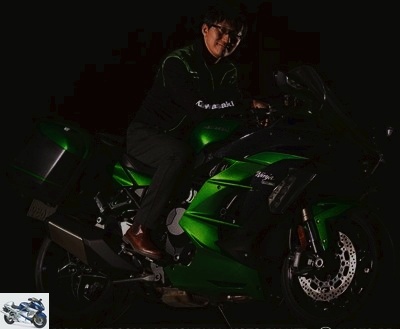
Renewed but extended by 15 mm, the single-sided swingarm of the Ninja H2 SX is teamed up again with the KYB shock absorber mounted on the 2015 and 2016 Ninja H2s. The rear suspension is fully adjustable (well considering the remote preloading wheel! ), like the inverted 43 mm fork that continues to equip the Ninja H2 "short".
The braking system is entrusted to the front to two 320 mm discs – fiercely – bitten by "house" radially mounted 4-piston calipers (and not Brembo as on the Ninja H2 / R or ZX-10R). At the rear, a simple 250mm disc is pinched – somewhat weakly – by a 2-piston caliper.

The rims of the Ninja H2 SX resume the "star" and polished style – on the SE version imported into France, unlike the standard model … – of the original H2. If the front tire is the same size (120 / 70-17), the rear tire undergoes a small speed (190 / 70-17, -10 mm wide) in order to counterbalance the weight gain and the increase in measurements.
Finally, the Ninja H2 SX sports a pair of Bridgestone S21s which fits well with its road program. Mistreated on the Estoril circuit, or even overtaken in the exits of slow curves, the Japanese tires gave complete satisfaction on the road. Especially since some are very slippery in Portugal…
Electronic
Derived from the Ninja H2, the SX receives the same driving aids: the mandatory ABS in the first place, which is called KIBS at Kawasaki and takes into account the inclination of the motorcycle thanks to the inertial unit, in order to regulate more fine pressure in the hydraulic circuit … The engine brake can be configured in parallel via the KEBC.
After braking, the KCMF (Kawasaki Cornering Management Function) device does not go to sleep, quite the contrary: it monitors the parameters of the engine and the chassis – every 5 milliseconds! – and modulates the engine power according to its observations.
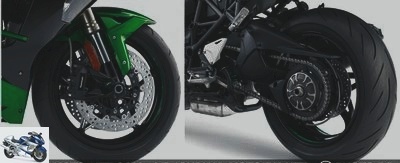
When the speed of rotation of the rear wheel exceeds – too much – that of the front wheel, the KTRC (Kawasaki Traction Control) intervenes on the throttle opening via the "Ride-by-wire", but can also delay or even cut ignition if necessary, while the rear tire regains grip.
Three more or less intrusive levels (from 3 to 1) are offered by the traction control, which also acts as anti-wheeling. The pilot also has the possibility of disconnecting the traction-control … at his own risk! For information, the KTRC is reset on each restart and keeps the previous setting.
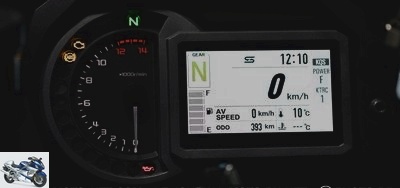
For the cowardsmore reasonable – who still bought the most extravagant road on the market! -, the motor can be electronically restricted: from 100% in "Full" mode, its performance can be reduced by about a quarter in "Middle" mode or by half in "Low" mode.
For the couriers / delivery people more nervous, the KLCM (Kawasaki Launch Control Mode, present on the SE only) simplifies the departures handle in the corner: the engine speed does not exceed 6250 rpm, allowing the pilot to concentrate on releasing the clutch. The system disengages when 150 km / h are exceeded, or when 3rd gear is engaged (see our onboard video).

For the lazy more sophisticated, the Ninja H2 SX (still SE version) also receives the KQS (Kawasaki Quick Shifter) as standard, which allows gear changes, both ascent and descent, without intervening on the clutch. Unlike the "sports start" assistant, this shifter is useful on a daily basis. MNC adopted it.
Le Journal moto du Net, however, was unable to verify the value of the cornering lighting offered on the "SX SE". "Each of the three lights integrated in each side of the fairing has a fixed orientation but lights up according to the angle of inclination", describe the Japanese. To be tested at night therefore.
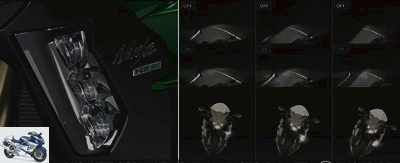
Tested and approved by MNC, the cruise control works perfectly: a push on the button (on the left, practical) and the electronics keep the bike at the chosen pace. Two additional buttons then allow you to vary your speed according to traffic or limitations…
Finally, on the SE version, a TFT active matrix LCD color screen – "a Kawasaki first", congratulate the Greens! – allows you to configure these numerous assistances and to monitor a lot of data and information. Site has also produced a "smart-video" on this subject. Good viewing !
Related articles
-
Ninja H2 SX test: sporty road bike, in green and against everything ! Kawasaki has no shortage of air: three years after the launch of its Ninja H2 / R,…
-
Ninja 650 test: Kawasaki camouflages its road in sport In 2017 Kawasaki introduces a new Ninja ! Not a pistarde just approved for the road, but the…
-
Ninja 650 test: Kawasaki camouflages its road in sport In 2017 Kawasaki introduces a new Ninja! Not a pistarde just approved for the road, but the…
-
Ninja H2 SX test: sporty road bike, in green and against everything ! Kawasaki has no shortage of air: three years after the launch of its Ninja H2 / R,…
-
2018 BMW F 750 GS and F 850 GS test: which one to choose ? In 2018, the BMW F750GS and F850GS gain in displacement and technology to succeed the F700GS…
-
Honda CBR1000RR / SP 2017 test: neither gross nor submitted ! Forget the old CBR1000RR lacking in performance and technology: Honda celebrates 25 years…
-
2017 Kawasaki Z1000SX review: a super bike for the road Kawasaki is taking advantage of the changeover to Euro 4 to refine its Z1000SX on many fronts:…
-
2017 Kawasaki Z1000SX review: a super bike for the road Kawasaki is taking advantage of the switch to Euro 4 to polish its Z1000SX on many fronts:…
-
Ninja 650 test: Kawasaki camouflages its road in sport In 2017 Kawasaki introduces a new Ninja! Not a pistarde just approved for the road , but the…
-
Kawasaki Z125 and Ninja 125 test: for generation Z or ZX-R bikers ? Unveiled in September, the Z125 and Ninja 125 land in mid-December in dealerships….